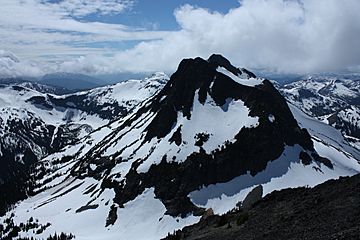Coquihalla Mountain facts for kids
Quick facts for kids Coquihalla Mountain |
|
|---|---|

Eastern flank of Coquihalla Mountain
|
|
| Highest point | |
| Elevation | 2,157 m (7,077 ft) |
| Prominence | 816 m (2,677 ft) |
| Listing | List of volcanoes in Canada List of Cascade volcanoes |
| Geography | |
| Location | British Columbia, Canada |
| Parent range | Bedded Range |
| Topo map | NTS 92H/11 |
| Geology | |
| Age of rock | 22 million years |
| Mountain type | Stratovolcano |
| Volcanic arc/belt | Pemberton Volcanic Belt Canadian Cascade Arc |
| Last eruption | 21 million years |
Coquihalla Mountain is a very old, inactive volcano found in British Columbia, Canada. It's located in the southwestern part of the province, about 10 kilometers (6 miles) south of Falls Lake. This mountain stands tall between the Coquihalla and Tulameen rivers.
Coquihalla Mountain is a type of volcano called a stratovolcano. This means it's built up from many layers of hardened lava, ash, and rocks that erupted over a long time. It is the highest peak in the Bedded Range, reaching an elevation of 2,157 meters (7,077 feet). It really stands out because it rises 816 meters (2,677 feet) above the nearby mountains.
What is Coquihalla Mountain?
Coquihalla Mountain is an extinct volcano. This means it hasn't erupted in a very, very long time and scientists don't expect it to erupt again. It's part of a group of mountains known as the Canadian Cascades. These mountains are near the Coast Mountains to the west and the Interior Plateau to the east.
How Coquihalla Mountain Formed
Coquihalla Mountain was formed about 21 to 22 million years ago. It is a key part of something called the Pemberton Volcanic Belt. This belt is a chain of volcanoes that formed because of a process called subduction.
Subduction happens when one of Earth's large tectonic plates slides underneath another. In this case, the Cascadia subduction zone caused the land to melt deep underground. This melted rock, called magma, then rose to the surface, creating volcanoes like Coquihalla Mountain. The last time this volcano erupted was around 21 million years ago.

